

To learn about the First Mixer, read the
Circuit Details - First Mixer & Amplifier
before building this section.
To learn about the Crystal Filter, read the
Circuit Details - Crystal Filter
before building this section.

| To get the best print of the above picture, right click the mouse on the image, select "View Image". In the new browser window, click print, set layout to "Landscape", then "OK" to print. |

SWL ModificationsOnly one crystal and 4 100pf capacitors are used in each of the 3.547MHz and the 4.000MHz crystal filters. A jumper wire is used to bypass the area that is left out of the filters. The IR LED that normally points to the VFO amplifiers is installed pointed straight up as the Crystal Filter to VFO IR path is not used in the SWL receiver. If a good outside SWL antenna is going to be used, the 100K resistors at Gate 1 of the Mixer MOSFETS should be replaced by 470 ohm resistors. This modification increases the dynamic range and stability of the first mixer. See image at top of page. |


|
Insert all the components that have their values inside the footprint. They are the following: ____2 - RF Chokes (Bag 3), Footprint on PCB is rectangle with square edges ,"RF" inside the rectangle. Choke is about the size of a 1 watt resistor with rounded edges. They are at the input to the crystal filters. |

|
Solder ____25 - .01 capacitors (Bag 3) |

|
Solder ____8 - 100 ohm resistors (brown, black, brown) (Bag 3) |

|
Solder ____8 - 100K resistors (brown, black, yellow) (Bag 3) |

|
Solder Note: If a good antenna is going to be used with this receiver, use 470 ohm resistors at Gate 1 of the Mixer MOSFET instead of the 100K shown. See image at top of page. Solder Resistors:____3 - 470 ohm (Bag 4), One is located at the top left of the first mixer, and the other two are located to the top and right of the IR LEDs. |

|
Solder Capacitors (Going left to right on the board):____4 - 100pf NPO caps (Bag 3), Orange color, short leads flared out, labeled "101". All located inside the crystal filters. Only the input and output capacitors are installed. Two are installed right before the first crystal footprint and two are installed just after the third crystal and the output T4-6T transformer in each filter. The four capacitors inside the filter are not installed. Picture Solder Other Parts:____6 - LEDs (Bag 3), Red colored, match the flat on the LED to the flat on the footprint. The short lead is on the same side as the flat. Note: If you ordered the Super Bright LEDs, you can place two of them at the input of the crystal filter, next to the IR LEDs. Use different colors to help crystal filter identification. If you ordered the Bright Red LEDs, they can replace the ones in the mixer. See Modifying the LEDs. Solder |

|
____2 - IR LED (Bag 4), Smoky colored, on a cardboard strip, do not cut the leads off the strip, tear the IR LEDs off the strip and clean the bottom of the leads. Located at the input to the crystal filters, right next to 100pf caps. The short lead is on the same side as the flat. Mount as high as possible using the full lead length.
The one on the left side is installed but not used, just aim this IR LED straight up. The IR LED near the outside of the board (right side) points to the phototransistor at the Crystal Oscillator on Board 2. Wait till you mount the boards to aim this IR LED. Solder ____2 - VN0106N3 (Bag 2), static sensitive part, touch a ground lead before removing the part from the bag. Match the flat on the part to the flat on the footprint. Spread the outside leads slightly to fit the footprint. Marked "SI N, 0106, 8302". Solder ____1 - 3.457MHz crystal (Bag 4), Has a gray plastic cover over the crystal with the markings "NYMPH C O 17915-03". Only one crystal is used in the Crystal Filter Section. Solder the one crystal in the first Crystal Footprint at the bottom of the filter at the input. Picture____1 - 4.000MHz crystal (Bag 4), The markings are "4000 KSS 2FT". Only one crystal is used in the Crystal Filter Section. Solder the one crystal in the first Crystal Footprint at the bottom of the filter at the input. Picture ____1 - 1 1/2" of Hookup Wire, Solder a piece of hookup wire between the hole in the 100pf capacitor footprint to the hole in the third crystal footprint that is closest to the output in the 3.547 MHz crystal filter. Picture ____1 - 1 1/2" of Hookup Wire, Solder a piece of hookup wire between the hole in the 100pf capacitor footprint to the hole in the third crystal footprint that is closest to the output in the 4.000 MHz crystal filter. Picture Solder ____1 - T4-6T Minicircuits 1:4 transformer (Bag 4), Note the dot on the part and match it to the dot on the footprint. A dot is outside the footprint so that you can double check your work after it is mounted. Located at the output of the crystal filter.Solder ____2 - FT50A-75 Ferrite Cores, enamel wire (Bag 4), Cores were wound with a Bifilar winding and a 5 Turn winding in the "Preparation" section. These are located at the ends of the Mixer/Amplifier. Be careful to get the windings soldered on the board correctly according to the footprint. The lead that has two wires twisted together goes in the middle hole. |

|
Solder ____1 - FT50A-75 Ferrite Core, enamel wire (Bag 4), Core was wound with a Bifilar winding in the "Preparation" section. This core goes in the middle of the Mixer/Amplifier. |
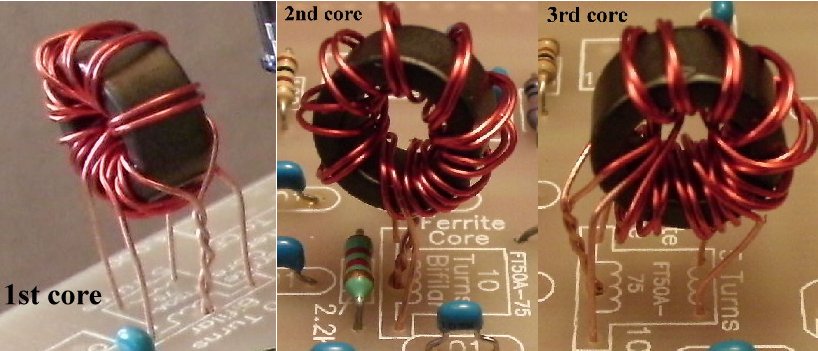
|
Solder Please Check!Carefully inspect the wires on the bifilar side of the cores and make sure they are not shorted. There is no ohm meter check for this error, so you must look carefully. Make sure the bare parts of the wires are not touching! Double check underneath the board to make sure there is not a solder bridge between the leads. The second and third core (counting from the front) carry 12 Volts. If the bifilar leads are shorted there will be some burning (smoke) of the wires, the LEDs will not light up, and the RF Choke that feeds 12 Volts to that core will need to be replaced. ____4 - MOSFETs (Bag 2), (Picture) static sensitive part, touch a ground wire before taking it out of the bag, notice the dot on MOSFET (may be difficult to see, hold at an angle to a light source and you can see the shadow of the dot), the dot is located to the left of the second line of the text on the MOSFET. A dot is placed outside the footprint so that you can double check your placement after it has been soldered to the PCB. The leads on each side of the part need to spread apart slightly to fit the footprint. Solder ____1 - SPDT Miniature PC Mount switch (Bag 5), There is a switch footprint in front of the First Mixer. There are two hole patterns. Mount the switch in the holes that work. Picture |

| ____Crystal Filters (Picture) - Between the VN0106N3's, there is a BOLD circle that is labeled "Gnd for 30/17" and marked "CF". Solder a 7 1/2" length of wire to the circle and to the terminal marked "To CF" on the Crystal Filter switch. |
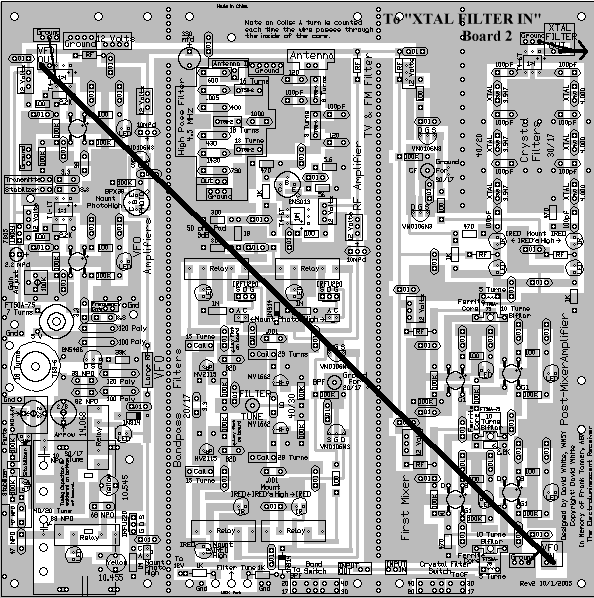
|
____Miniature Coax Cable, cut a 12 1/2" piece (Bag 6), The coax is used between the VFO OUT in the upper left hand side of the board, to the VFO IN at the lower right hand side of the board. The coax supplied with the kit is Teflon 75 ohm cable. The best way to strip the insulation is to get a very sharp utility knife and slice a 1" section length wise, then fold over the cable and pull the shielding/center out of the insulation. Pull back the shielding slightly to loosen, make a small hole at the bottom, and pull through the center wire. Since it is Teflon, there is no danger of burning up the insulation on the center wire and causing a short while soldering. Pictures and Instructions for using the Teflon coax.Best to mount this jumper underneath the board for a cleaner appearance and avoid interfering with the IR switching at the bandpass filters. When soldering underneath the board, solder to the traces and the ground plane. Saturate the ground braid with solder first, then solder the braid to the ground plane. Next solder the center wire to the output(VFO OUT)/input(VFO IN) pads. Pictures ____Miniature Coax Cable, cut a 10" piece (Bag 6). Strip and prepare as explained above. ____Solder the center wire to "XTAL FILTER OUT", solder the braid to the "Ground" box. Leave the other end loose at this time. |

|
____Check the dot on the Minicircuits T4-6T transformer. |

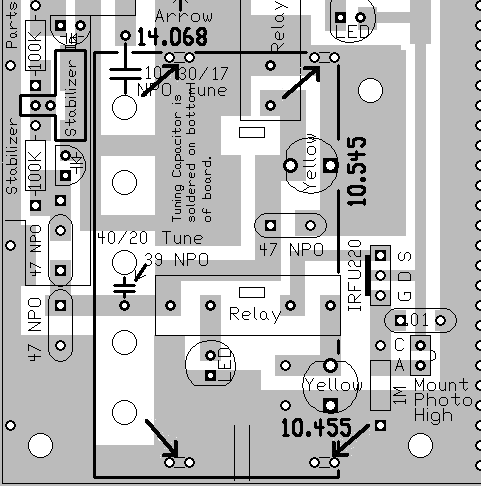
| ____1 - 5 section tuning capacitor (Bag 1), Note the double holes inside the footprint of the tuning capacitor: this is where the mounting legs of the capacitor will mount underneath the board. |

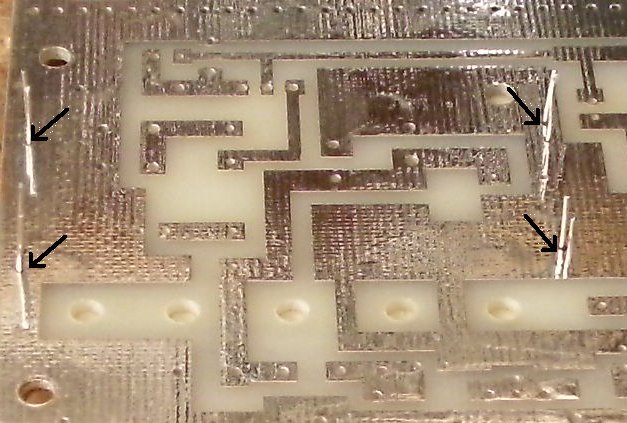
|
As shown above, get four (4) of the resistor lead trimmings. Using needle nose pliers, bent them in a U shape with about a 1/8" flat. This means bending them right at the tip of the pliers. Run them through the capacitor hole mountings from the top. Cut small pieces of masking tape (or any sticky tape) to hold them against the top board. |


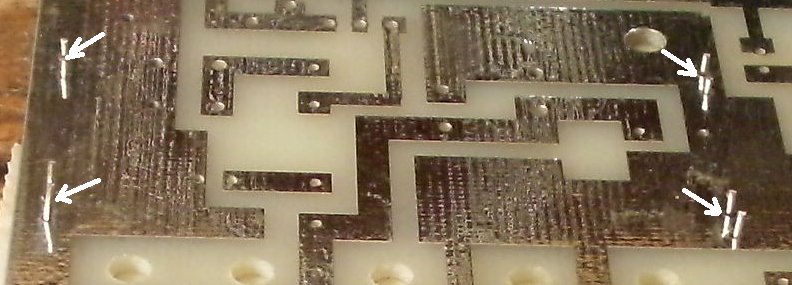
|
Trim each leg of the U shaped pieces to about 1/8" long as shown in the above picture. The legs of the capacitor are just a hair longer than 1/8" Pull the NPO capacitor leads (the 2 caps that will be connecting to the soldering lugs) from the top of the board up out of the holes. Tin the capacitor mounting legs so it will be easy to apply solder to them as shown in the following pictures. Be sure to apply enough heat to the legs so that they accept solder. You may need to use a slightly larger tip (and higher temperature) on the soldering gun so that more heat can be applied to the joint. |

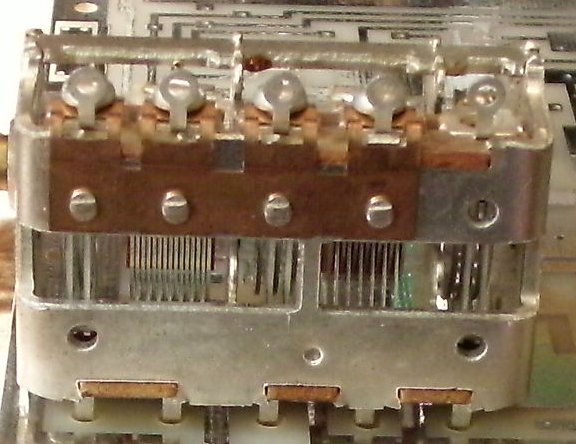
|
Lay the tuning capacitor on the board beside the U shaped pieces and slide the capacitor until the side soldering lugs are directly above the holes. The capacitor lugs should fall down into the holes very slightly. The legs should slip in between the U shaped pieces and the capacitor should be straight and the soldering lugs in the holes. |
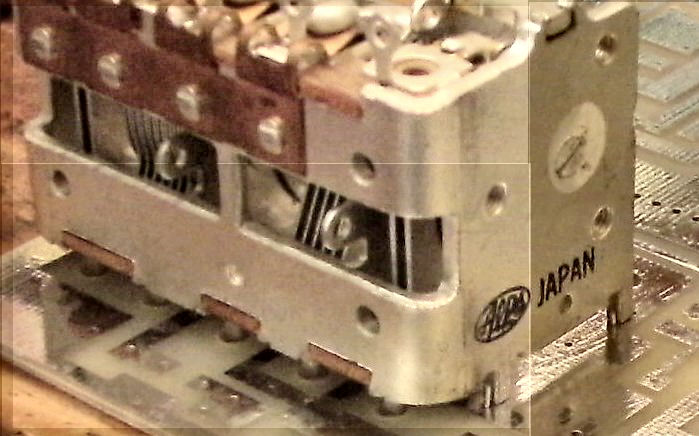
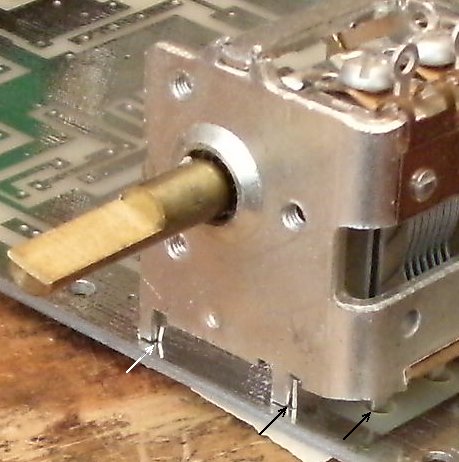
|
When the capacitor looks like the above pictures with the U shaped wires hugging the legs of the capacitor, solder very carefully. Solder the wire onto the leg first. Check alignment, and then pour solder down onto the ground plane too. After one leg has been soldered in place, then the others should be no problem. |
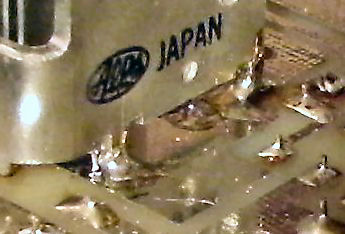

|
After the capacitor has been mounted to the board, solder the 39pf capacitor to the middle tab, and the 47pf to the back tab of the capacitor (where the 10pf normally goes), as shown on the silkscreen. ____1 - Large Knob (Bag 6), Mount on tuning capacitor using small screwdriver.Please note: When mounting the capacitor on a ground plane, without the holes for the soldering tabs, the tabs will be forcefully grounded on the ground plane because their length is as long as the mounting legs. Bend the soldering tabs up and against the stator connections to keep from grounding the stator sections, when mounting on PCB ground planes other than the receiver's PCB. Picture |
| You can test Board 1 now, then build and test Board 2, or build both boards, then test both after you finish. |
Send E-Mail || Amateur Radio Receivers || Electroluminescent Receiver || Construction of the Kit || Back to SWL Instructions

